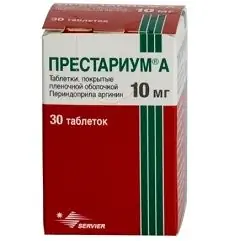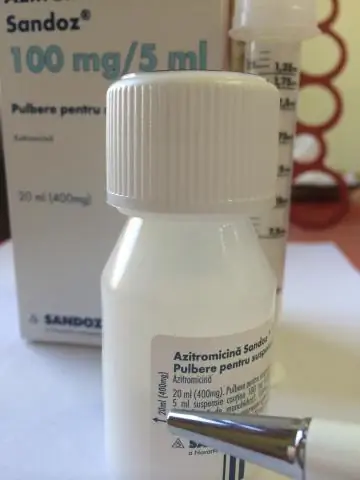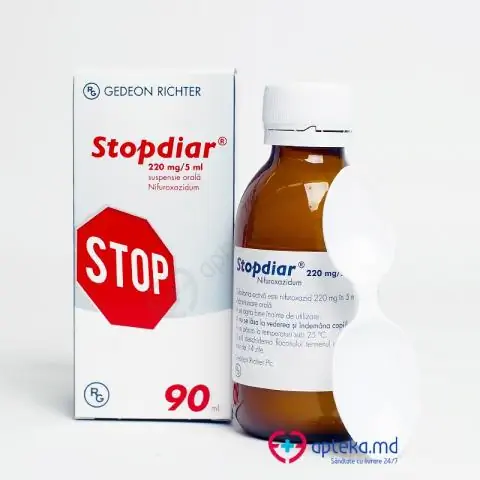- Author Rachel Wainwright [email protected].
- Public 2023-12-15 07:39.
- Last modified 2025-11-02 20:14.
Prestarium A
Latin name: Prestarium A
ATX code: C09AA04
Active ingredient: Perindopril (Perindopril)
Producer: Les Laboratoires Servier Industrie (France)
Description and photo update: 19.10.2018
Prices in pharmacies: from 265 rubles.
Buy

Prestarium A is a drug with a hypotensive, vasodilating effect.
Release form and composition
Dosage forms of release:
- film-coated tablets: 2.5 mg each - white, biconvex, round; 5 mg each - light green, rounded on both sides, oblong, with notches on two sides, one of the front sides is engraved in the form of a company logo; 10 mg each - green, biconvex, round, engraved on one side in the shape of a heart, on the other - a logo (14, 29 or 30 pcs. in polypropylene bottles with a dispenser, 1 bottle in a cardboard box);
- dispersible tablets in the oral cavity: white, biconvex, round (30 pcs. in polypropylene bottles with a dispenser, 1 bottle in a cardboard box).
Composition of 1 coated tablet:
- active substance: arginine perindopril - 2.5; 5 or 10 mg (perindopril - 1.6975; 3.395 or 6.79 mg);
- auxiliary components (2.5 / 5/10 mg): maltodextrin - 4.5 / 9/18 mg; sodium carboxymethyl starch - 1.35 / 2.7 / 5.4 mg; hydrophobic colloidal silicon dioxide - 0.135 / 0.27 / 0.54 mg; lactose monohydrate - 36.29 / 72.58 / 145.16 mg; magnesium stearate - 0.225 / 0.45 / 0.9 mg;
- casing (2.5 / 5/10 mg): premix for the film casing of Sepifilm 37781 RBC white, Sepifilm 4193 light green or Sepifilm NT 3407 green - 0.966 / 1.931 / 4.828 mg, respectively; macrogol 6000 - 0.034 / 0.069 / 0.172 mg.
Composition of 1 dispersible tablet:
- active substance: arginine perindopril - 2.5; 5 or 10 mg (perindopril - 1.698 / 3.395 / 6.79 mg);
- auxiliary components (2.5 / 5/10 mg): aspartame - 0.1 / 0.2 / 0.4 mg; magnesium stearate - 0.2 / 0.4 / 0.8 mg; acesulfame potassium - 0.1 / 0.2 / 0.4 mg; anhydrous colloidal silicon dioxide - 0.2 / 0.4 / 0.8 mg; dry mixture of starch and lactose (lactose monohydrate - 85%; corn starch - 15%) - 36.9 / 73.8 / 147.6 mg.
Pharmacological properties
Pharmacodynamics
Prestarium A belongs to the ACE inhibitors (angiotensin-converting enzyme). ACE (kininase II) is an exopeptidase that converts angiotensin I to angiotensin II (a vasoconstrictor) and the destruction of bradykinin (a substance with a vasodilating effect) to an inactive heptapeptide.
As a result of the use of Prestarium A, the plasma concentration of angiotensin II in the blood decreases, which leads to a decrease in the secretion of aldosterone and an increase in the activity of renin in the blood plasma.
ACE inactivates bradykinin, therefore, suppression of ACE is accompanied by an increase in the activity of the circulating and tissue kallikrein-kinin systems, while the prostaglandin system is also activated. There is a possibility that this effect is part of the mechanism of the antihypertensive action of ACE inhibitors, as well as the mechanism of the appearance of some adverse reactions of drugs of this class (in particular, cough).
The therapeutic effect is due to the active metabolite - perindoprilat. Other metabolites of the drug do not have an inhibitory effect on ACE.
Clinical efficacy and safety of the drug:
- arterial hypertension: the drug is effective in the treatment of arterial hypertension of any severity. In addition, there is a decrease in systolic and diastolic pressure in the standing and lying position of the patient. Perindopril reduces the total peripheral vascular resistance, which leads to a decrease in blood pressure (blood pressure), while the peripheral blood flow is accelerated without changing the heart rate. After a single oral administration, the antihypertensive effect of Prestarium A reaches its highest values after 4-6 hours and lasts for 24 hours. A decrease in blood pressure is achieved quickly enough. If there is a positive response to treatment, blood pressure normalization occurs within a month and persists without the development of tachyphylaxis. Cancellation of therapy is not accompanied by the development of the rebound effect. Perindopril reduces left ventricular hypertrophy, has a vasodilator effect, helps to restore the structure of the vascular wall of small arteries and the elasticity of large arteries. The antihypertensive effect is enhanced when combined with thiazide diuretics;
- cerebrovascular diseases: according to research results, Prestarium A promotes a persistent decrease in blood pressure. There is also a significant decrease in the likelihood of recurrent stroke. Additionally, there is a significant reduction in the risk of the following diseases / conditions: fatal or disabling strokes, major cardiovascular complications, including myocardial infarction, severe cognitive impairment, stroke-related dementia. This effect of the drug is observed in patients with normal blood pressure / arterial hypertension, regardless of gender, age, absence / presence of diabetes mellitus;
- stable coronary artery disease (ischemic heart disease): according to studies, when using Prestarium A, there is a significant decrease in the absolute risk of the onset of the combined endpoint;
- patients under 18 years of age: efficacy and safety have not been studied;
- double blockade of RAAS: no significant positive effect of combination therapy with ACE inhibitors and angiotensin II receptor antagonists (ARA II) was revealed; in patients with diabetic nephropathy, a combination of these drugs should not be used.
Pharmacokinetics
Absorption and metabolism: perindopril is rapidly absorbed from the gastrointestinal tract, reaching C max (maximum concentration of the substance) in blood plasma occurs after 1 hour. T 1/2 (half-life) of substances from blood plasma - 1 hour. Perindopril has no pharmacological activity. About 27% of the total amount of absorbed perindopril enters the bloodstream as an active metabolite - perindoprilat. Time to reach it C maxin blood plasma - 3-4 hours. In the process of metabolism, in addition to perindoprilat, 5 more metabolites that do not have pharmacological activity are formed. When used simultaneously with food intake, the conversion of perindopril to perindoprilat slows down, which affects its bioavailability. In this regard, Prestarium A is prescribed 1 time per day in the morning before meals. The relationship between the dose of perindopril and its plasma concentration is linear.
Distribution: the binding of perindoprilat to blood plasma proteins is dose-dependent and amounts to 20%. V d of free perindoprilat is about 0.2 l / kg.
Excretion: excretion of perindoprilat occurs by the kidneys, the final T 1/2 of the free fraction is approximately 17 hours, the equilibrium state is achieved as a result within 4 days. In elderly patients, as well as in renal / heart failure, a slowdown in the excretion of the substance is observed. The dialysis clearance of perindoprilat is 70 ml / min. The hepatic clearance of perindopril in liver cirrhosis is reduced by 2 times, the amount of perindoprilat formed, however, does not decrease (there is no need to adjust the dose of the drug).
Indications for use
- arterial hypertension;
- stable coronary artery disease (in order to reduce the likelihood of developing cardiovascular complications);
- chronic heart failure;
- prevention of repeated stroke (in combination with indapamide) in patients who have suffered a stroke or transient ischemic cerebrovascular accident.
Contraindications
Absolute:
- hereditary / idiopathic angioedema;
- burdened history of angioedema (angioedema) associated with the use of ACE inhibitors;
- syndrome of glucose-galactose malabsorption, lactose intolerance, lactase deficiency;
- combination therapy with aliskiren and drugs containing aliskiren in patients with diabetes mellitus or impaired renal function (glomerular filtration rate <60 ml / min / 1.73 m 2);
- pregnancy and the period of breastfeeding;
- age up to 18 years;
- individual intolerance to the components of the drug and other ACE inhibitors.
Relative (diseases / conditions that require caution):
- desensitizing therapy;
- reduced volume of circulating blood associated with taking diuretics, adherence to a salt-free diet, vomiting, diarrhea;
- cerebrovascular diseases;
- bilateral stenosis of the renal arteries or the presence of only one functioning kidney;
- systemic connective tissue diseases (including systemic lupus erythematosus, scleroderma);
- renal failure;
- angina pectoris;
- diabetes;
- renovascular hypertension;
- chronic heart failure (NYHA classification - IV functional class);
- hyperkalemia;
- hemodialysis using high-flow membranes;
- general anesthesia / surgery;
- conditions after kidney transplantation;
- low-density lipoprotein apheresis;
- combined use with the following drugs: immunosuppressants, allopurinol, procainamide (due to the likelihood of agranulocytosis and neutropenia), as well as potassium-sparing diuretics, potassium and lithium preparations, potassium-containing substitutes for table salt;
- belonging to the Negroid race;
- hypertrophic obstructive cardiomyopathy / aortic or mitral stenosis.
Instructions for use of Prestarium A: method and dosage
Tablets are taken orally, preferably before meals in the morning, 1 pc. 1 per day.
The dispersible tablet should be placed on the tongue and swallowed with saliva after disintegrating on the surface of the tongue.
When choosing a dose, the characteristics of the clinical situation and the degree of decrease in blood pressure during treatment should be taken into account.
Arterial hypertension
Prestarium A can be used as a monopreparation or in combination with other medicinal products.
The recommended starting daily dose is 5 mg.
With pronounced activation of the RAAS (especially against the background of renovascular hypertension, with a decrease in the content of electrolytes in the blood plasma and / or hypovolemia, decompensation of severe arterial hypertension or chronic heart failure), after taking the first dose of Prestarium A, a pronounced decrease in blood pressure may develop. At the beginning of the use of the drug, the condition of such patients must be carefully monitored. In these cases, therapy is recommended to start with a reduced initial daily dose of 2.5 mg, with a possible subsequent increase to 10 mg per day.
At the beginning of the use of the drug, symptomatic arterial hypotension may appear. In combination therapy with diuretics, the likelihood of arterial hypotension is higher, which is associated with possible hypovolemia and a decrease in the plasma electrolyte content in the blood. In this group of patients, the use of Prestarium A requires caution. If possible, it is recommended to stop taking diuretics 2-3 days before the start of therapy. If this is not possible, the drug is prescribed at 2.5 mg per day under the control of renal function and serum potassium in the blood. If necessary, it is possible to increase the dose of Prestarium A and resume diuretic therapy.
The recommended starting daily dose for elderly patients is 2.5 mg. After a month, if necessary, it can be doubled, then, taking into account the state of renal function, up to 10 mg (maximum).
Heart failure
The initial daily dose is 2.5 mg. Therapy can be carried out in combination with other drugs (potassium-sparing diuretics, digoxin, beta-blockers) under close medical supervision. With good tolerance and a satisfactory response after 2 weeks of use, the dose can be increased by 2 times.
In cases of a severe course of the disease, as well as in patients who belong to a high-risk group (with impaired renal function and a tendency to imbalance in water and electrolyte balance, combined therapy with vasodilator drugs and / or diuretics), therapy should be started while monitoring the condition patients.
If there is a high risk of symptomatic arterial hypotension, all the conditions listed above should be corrected if possible before starting Prestarium A. At the beginning and during treatment, it is necessary to control the value of blood pressure, renal function and plasma potassium in the blood.
Prevention of recurrent stroke
With a burdened history of cerebrovascular diseases during the first 14 days of therapy, Prestarium A is prescribed in a daily dose of 2.5 mg, after which it is doubled over the next 14 days (before the appointment of indapamide).
Treatment can be started at any time (from 2 weeks to several years after a stroke).
Cardiac ischemia
The initial dose for a stable course of ischemic heart disease is 5 mg per day. If the tolerance to therapy is good, as well as the functional state of the kidneys allows, after 14 days the dose is doubled.
For elderly patients, Prestarium A is prescribed during the first week in a reduced initial dose of 2.5 mg per day, then for the next 7 days, 5 mg is used, after which, with good tolerance, it is possible to increase the dose to a maximum of 10 mg per day.
Special patient groups
In renal failure, the drug is prescribed depending on creatinine clearance:
- ≥ 60 ml / min: 5 mg daily;
- 30-60 ml / min: 2.5 mg daily;
- 15-30 ml / min: 2.5 mg once every 2 days;
- <15 ml / min (hemodialysis patients): 2.5 mg per day of dialysis (after the procedure).
Side effects
Most often, when using Prestarium A, the development of the following disorders is observed: headache, vertigo, paresthesia, tinnitus, dizziness, visual disturbances, excessive decrease in blood pressure, cough, shortness of breath, diarrhea, constipation, abdominal pain, dyspepsia, taste disturbances, nausea, vomiting, skin rash / itching, asthenia, muscle spasms.
The safety profile of Prestarium A is consistent with the safety profile of ACE inhibitors.
Possible adverse reactions (> 10% - very common;> 1% and 0.1% and 0.01% and <0.1% - rarely; <0.01% - very rare; with an unknown frequency - if it is impossible to assess frequency of occurrence of adverse reactions):
- sense organs: often - tinnitus, visual impairment;
- lymphatic system / blood: infrequently - eosinophilia; very rarely - a decrease in hematocrit and hemoglobin, thrombocytopenia, neutropenia / leukopenia, pancytopenia, agranulocytosis, in patients with congenital glucose-6-phosphate dehydrogenase deficiency - hemolytic anemia;
- cardiovascular system: often - an excessive decrease in blood pressure, including the symptoms associated with this disorder; infrequently - tachycardia, vasculitis, palpitations; very rarely - angina pectoris, cardiac arrhythmias; in high-risk patients - myocardial infarction and stroke, which are probably associated with an excessive decrease in blood pressure;
- central nervous system: often - vertigo, paresthesia, dizziness, headache; infrequently - mood lability, sleep disturbances, fainting, drowsiness; very rarely - confusion of consciousness;
- digestive system: often - abdominal pain, constipation, vomiting, nausea, taste disturbances, diarrhea, dyspepsia; infrequently - dryness of the oral mucosa; very rarely - pancreatitis, cytolytic / cholestatic hepatitis;
- respiratory system: often - shortness of breath, cough; infrequently - bronchospasm; very rarely - rhinitis, eosinophilic pneumonia;
- musculoskeletal system: often - muscle spasms; infrequently - myalgia, arthralgia;
- subcutaneous fat / skin: often - rash, itching; infrequently - increased sweating, pemphigus, photosensitivity; very rarely - erythema multiforme;
- reproductive system: infrequently - erectile dysfunction;
- urinary system: infrequently - renal failure; very rarely - renal failure in acute course;
- allergic reactions: infrequently - urticaria, angioedema of the larynx, face, lips, tongue, limbs, vocal folds, mucous membranes;
- laboratory indicators: rarely - increased serum bilirubin and hepatic transaminase activity; infrequently - an increase in the concentration of creatinine and urea in the blood plasma;
- metabolism: infrequently - hyponatremia, hypoglycemia, reversible hyperkalemia;
- general reactions: often - asthenia; infrequently - chest pains, falls, fever, peripheral edema, weakness.
Overdose
Overdose information is limited.
The main symptoms: palpitations, cough, bradycardia, anxiety, dizziness, renal failure, shock, marked decrease in blood pressure, hyperventilation, tachycardia, electrolyte imbalance.
Therapy: with a pronounced decrease in blood pressure, the patient should be transferred to the supine position and his legs should be raised; if necessary, a 0.9% sodium chloride solution, a solution of catecholamines is injected intravenously. The active metabolite of perindopril, perindoprilat, can be removed from the body by dialysis. With the development of therapy-resistant bradycardia, an artificial pacemaker may be required. The indicators of the basic vital functions of the body, serum concentration of electrolytes and creatinine in the blood should be constantly monitored.
special instructions
If Prestarium A is used in coronary artery disease to reduce the risk of cardiovascular complications in patients who have previously had myocardial infarction and / or coronary revascularization, in cases of unstable angina pectoris during the first month of taking the drug, before continuing treatment, it is necessary to assess the benefit-risk ratio.
With arterial hypotension, it is necessary to take into account that taking Prestarium A can cause a sharp decrease in blood pressure. The development of symptomatic arterial hypotension is rarely observed in patients with uncomplicated arterial hypertension. An increased risk arises against the background of a reduced circulating blood volume (due to diuretic therapy, strict adherence to a salt-free diet, hemodialysis, vomiting and diarrhea, as well as in severe hypertension with high renin activity). The appearance of symptomatic arterial hypotension can be observed with clinical manifestations of heart failure with / without renal failure. This group of patients requires careful monitoring of blood pressure, renal function and serum potassium in the blood.
This approach is also applicable to patients with coronary artery disease with cerebrovascular diseases, in whom severe arterial hypotension can cause myocardial infarction or cerebrovascular accident.
In cases of development of arterial hypotension, the patient must be transferred to the supine position and his legs raised. If necessary, the volume of circulating blood is replenished (0.9% sodium chloride solution intravenously). Transient arterial hypotension is not the reason for the complete cancellation of therapy; resumption of treatment is possible after the restoration of circulating blood volume and blood pressure.
When symptoms of a pronounced decrease in blood pressure appear, a dose reduction / discontinuation of therapy is required.
With obstruction of the outflow tract of the left ventricle (hypertrophic obstructive cardiomyopathy, aortic stenosis), as well as with mitral stenosis, Prestarium A should be administered with caution.
Arterial hypotension, which in some cases develops at the beginning of drug use in patients with symptomatic chronic heart failure, can cause deterioration of renal function and the development of acute renal failure (usually reversible).
During therapy in patients on hemodialysis using high-flow membranes, there is information about the occurrence of anaphylactic reactions. In these cases, it is recommended to use a different type of dialysis membrane or prescribe a different antihypertensive drug.
If hypersensitivity / angioedema develops, urgent measures may be required, especially if the swelling affects the tongue, vocal folds, or larynx.
When taking Prestarium A, patients with a history of angioedema not associated with taking ACE inhibitors may have an increased risk of its development.
There is evidence of rare cases of development of angioedema of the intestine. In this case, abdominal pain with / without nausea and vomiting can be observed, in some cases without previous angioedema of the face and with a normal level of C1-esterase (must be taken into account when conducting differential diagnosis).
During the use of Prestarium A, anemia, agranulocytosis / neutropenia and thrombocytopenia may occur. In the absence of impaired renal function and other aggravating factors, neutropenia rarely develops. Caution is required in the following cases, especially in the presence of an initial renal dysfunction: the presence of systemic connective tissue diseases, combined use with immunosuppressants, allopurinol or procainamide.
Some patients developed severe infections, in some cases showing resistance to intensive antibiotic therapy. In such patients, it is recommended to periodically monitor the content of leukocytes in the blood. Any signs of infection should be reported to your doctor.
In patients of the black race, the likelihood of developing angioedema is higher.
When carrying out the differential diagnosis of cough, it should be borne in mind that it may appear as a result of taking Prestarium A.
Therapy should be discontinued 24 hours before surgery and general anesthesia. In cases of arterial hypotension, blood pressure can be supported by replenishing the volume of circulating blood.
Risk factors for the appearance of hyperkalemia include: decreased renal function, renal failure, age from 70 years, diabetes mellitus, simultaneous use with potassium-sparing diuretics, some concomitant conditions (acute heart failure, dehydration, metabolic acidosis), intake of food supplements / potassium preparations or containing potassium substitutes for table salt, as well as the use of other drugs that increase the level of potassium in the blood.
If Prestarium A is prescribed for patients with diabetes mellitus, during the first month of treatment it is necessary to regularly monitor the concentration of glucose in the blood.
Against the background of diabetic nephropathy, Prestarium A should not be taken in combination with ARA II.
Influence on the ability to drive vehicles and complex mechanisms
When driving motor vehicles, one should take into account the possible development of side effects, including dizziness and arterial hypotension.
Application during pregnancy and lactation
According to the instructions, Prestarium A is contraindicated for use during pregnancy and lactation.
When planning / onset of pregnancy, the drug should be canceled immediately. If necessary, it is replaced by another drug with a proven safety profile of use in this group of patients.
If the patient took Prestarium A in the II - III trimesters of pregnancy, ultrasound is recommended to assess the condition of the skull and kidney function of the newborn.
Newborns whose mothers received ACE inhibitors during pregnancy should be monitored because of the risk of developing arterial hypotension.
Pediatric use
Age under 18 is a contraindication to taking Prestarium A, since the safety profile for patients of this age has not been studied.
With impaired renal function
Diseases / conditions in which taking Prestarium A requires caution:
- conditions after kidney transplantation;
- renal failure;
- bilateral renal artery stenosis or the presence of only one functioning kidney.
In renal failure, the dose of the drug is determined by creatinine clearance.
For violations of liver function
No dose adjustment is required for this group of patients.
There is information about rare cases of development of cholestatic jaundice with the transition to fulminant necrosis of the liver (possibly fatal). If jaundice occurs or a significant increase in the activity of liver enzymes occurs while taking Prestarium A, therapy is canceled. The patient's condition should be monitored.
Use in the elderly
With ischemic heart disease and arterial hypertension, elderly patients require dose adjustment.
Drug interactions
With the combined use of Prestarium A with certain drugs / substances, the following effects may develop:
- aliskiren: increased risk of hyperkalemia, deterioration of renal function and an increase in the incidence of cardiovascular morbidity and mortality (in diabetes mellitus or impaired renal function, the combination is contraindicated, in other cases, it requires caution);
- ARA II: an increase in the incidence of fainting, arterial hypotension, deterioration of renal function, hyperkalemia in patients with established atherosclerotic disease, diabetes mellitus or heart failure (the combination requires caution; combined therapy should be carried out with careful monitoring of potassium content, renal function and blood pressure);
- estramustine: increased risk of side effects, including angioedema (combination not recommended);
- potassium salts, potassium-sparing diuretics: increased risk of hyperkalemia (the combination is not recommended, if combined use is necessary, caution is required and regular monitoring of serum potassium in the blood is required;
- lithium preparations: the development of a reversible increase in the concentration of lithium in the blood serum and the associated toxic effects (the combination is not recommended; combination therapy is possible only under the control of the serum concentration of lithium in the blood);
- hypoglycemic agents: an increase in their hypoglycemic effect up to the development of hypoglycemia, especially at the beginning of therapy and with impaired renal function (the combination requires caution);
- other antihypertensive drugs, drugs with a vasodilating effect, including long-acting / short-acting nitrates: increasing the antihypertensive effect of perindopril (the combination requires certain caution);
- baclofen: increased antihypertensive effect of Prestarium A, which requires careful monitoring of blood pressure and, if necessary, adjustment of the dosage regimen (the combination requires caution);
- potassium-sparing diuretics: an increase in the likelihood of an excessive decrease in blood pressure (the risk decreases when the diuretic is discontinued, the loss of fluid or salts is replenished before the use of Prestarium A, as well as the appointment of lower doses of the drug with a gradual increase; in the first weeks of therapy, it is necessary to monitor renal function; the combination requires caution);
- potassium-sparing diuretics: an increase in the likelihood of hyperkalemia in the treatment of heart failure (NYHA classification - II-IV functional class) with left ventricular ejection fraction <40% and previously used ACE inhibitors and loop diuretics (the combination requires caution, before prescribing drugs, you must make sure that there are no violations renal function and hyperkalemia; it is recommended to regularly monitor the concentration of creatinine and potassium in the blood - in the first month of therapy once a week, then - once a month);
- nonsteroidal anti-inflammatory drugs, including acetylsalicylic acid in high doses (≥ 3 g per day): a decrease in the antihypertensive effect of Prestarium A, deterioration of renal function, an increase in serum potassium in the blood, especially with reduced renal function (the combination requires caution, especially when administered to the elderly patients; patients during treatment should receive an adequate amount of fluid, it is also recommended to carefully monitor renal function at the beginning and during the use of this combination);
- agents for general anesthesia, tricyclic antidepressants, antipsychotics: increased antihypertensive action of perindopril (the combination requires some caution);
- glyptins: an increase in the likelihood of angioedema (the combination requires some caution);
- gold preparations: the development of nitritoid reactions - a symptom complex, including symptoms such as arterial hypotension, vomiting, nausea, hyperemia of the facial skin (the combination requires certain caution);
- sympathomimetics: weakening the antihypertensive effect of perindopril (the combination requires some caution).
Analogs
The analogues of Prestarium A are: Arentopres, Hypernik, KOVEREKS, Perindopril, Perindopril erbumin A and B, Perineva, Perinpress, Pyristar, Prestarium and others.
Terms and conditions of storage
No special storage conditions are required. Keep out of the reach of children.
The shelf life of film-coated tablets is 3 years, dispersible tablets - 2 years.
Terms of dispensing from pharmacies
Dispensed by prescription.
Reviews about Prestarium A
According to reviews, Prestarium A is an effective and affordable drug that leads to the development of adverse reactions in rare cases. It is noted for its fast, stable and long-term action, as well as a convenient dosing regimen.
Price for Prestarium A in pharmacies
The approximate price for Prestarium A (30 pcs. In a package; 5/10 mg each) is 410-510 or 550-650 rubles.
Prestarium A: prices in online pharmacies
|
Drug name Price Pharmacy |
|
Prestarium A 5 mg orodispersible tablets 30 pcs. 265 RUB Buy |
|
Prestarium A 10 mg orodispersible tablets 30 pcs. RUB 314 Buy |
|
Prestarium A dispersion tablets 5mg 30 pcs. 320 RUB Buy |
|
Prestarium A 5 mg film-coated tablets 30 pcs. 402 RUB Buy |
|
Prestarium a tab. p.p. 5mg n30 409 r Buy |
|
Prestarium A dispersion tablets 10mg 30 pcs. 433 r Buy |
|
Prestarium a tab. p.p. 10mg n30 534 RUB Buy |
|
Prestarium A 10 mg film-coated tablets 30 pcs. 534 RUB Buy |
| See all offers from pharmacies |

Anna Kozlova Medical journalist About the author
Education: Rostov State Medical University, specialty "General Medicine".
Information about the drug is generalized, provided for informational purposes only and does not replace the official instructions. Self-medication is hazardous to health!






